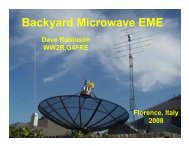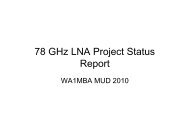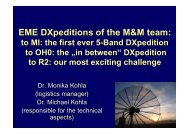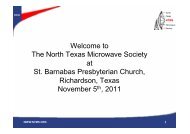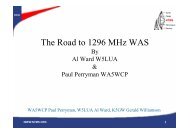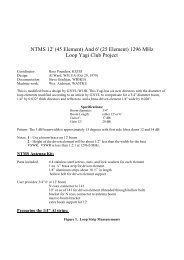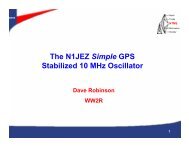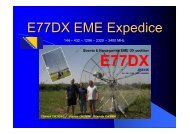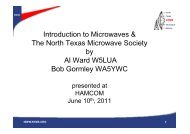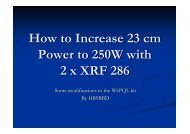Low-Noise VHF and L-Band GaAs FET Amplifiers - NTMS
Low-Noise VHF and L-Band GaAs FET Amplifiers - NTMS
Low-Noise VHF and L-Band GaAs FET Amplifiers - NTMS
You also want an ePaper? Increase the reach of your titles
YUMPU automatically turns print PDFs into web optimized ePapers that Google loves.
Reprint'1'j f~.J!11l RF Design, February 1989.<br />
rl letsfured fechnology _<br />
<strong>Low</strong>-<strong>Noise</strong> <strong>VHF</strong> <strong>and</strong> L-B<strong>and</strong><br />
<strong>GaAs</strong> <strong>FET</strong> <strong>Amplifiers</strong><br />
ByAIWard<br />
Avantek Inc.<br />
<strong>GaAs</strong> <strong>FET</strong> devices are typically used<br />
in low-noise amplifiers in the microwave<br />
region, where silicon transistors can't<br />
provide the required gain <strong>and</strong> noise<br />
perlormance. There are, however, many<br />
applications in the frequency range<br />
below 2000 MHz where the low noise<br />
figures <strong>and</strong> high gain of <strong>GaAs</strong> <strong>FET</strong>s can<br />
improve receiver sensitivity. This article<br />
describes a series of three low-noise<br />
amplifiers that use identical circuit topology.<br />
The only differences are in the<br />
proper choice of three inductors depending<br />
on the frequency of operation.<br />
The designs are centered at 450 MHz,<br />
900 MHz <strong>and</strong> 1300 MHz, but can be<br />
scaled for any frequency within the<br />
region of 400 to 1600 MHz. Each<br />
amplifier has a usable b<strong>and</strong>width of<br />
about 30 to 40 percent.<br />
Using a high-gain, high-frequency<br />
<strong>GaAs</strong> <strong>FET</strong> at <strong>VHF</strong> poses special<br />
problems. Of greatest concern is the<br />
problem of designing the amplifier for<br />
unconditional stability. Typically, <strong>GaAs</strong><br />
<strong>FET</strong>s have greater gain as frequency is<br />
decreased, e.g., 25 dB maximum stable<br />
gain at 500 MHz. A second problem is<br />
that matching the typical microwave<br />
<strong>GaAs</strong> <strong>FET</strong> at lower frequencies for<br />
minimum noise figure does not necessarily<br />
produce minimum input VSWR.<br />
Achieving the lowest possible noise<br />
figure requires matching the device to<br />
ropt (the source match required for<br />
minimum noise figure). At higher microwave<br />
frequencies this will generally<br />
produce a reasonable input VSWR,<br />
since r opt <strong>and</strong> the complex conjugate of<br />
the device input reflection coefficient S"<br />
are usually close on the Smith Chart. At<br />
lower frequencies, special consideration<br />
needs to be given to the input circuit<br />
design <strong>and</strong> to the tradeoffs required to<br />
ensure low noise figure while still achieving<br />
moderate gain, low VSWR <strong>and</strong><br />
unconditional stability.<br />
Design Technique<br />
The Avantek ATF-10135, supplied in<br />
the commercial 0.085 inch "micro-X"<br />
metal/ceramic packaqe, is used in these<br />
examples. Examination of the data sheet<br />
reveals that the device is capable of 0.4<br />
dB noise figure at frequencies below 2<br />
GHz with an associated gain of greater<br />
than 15 dB. The noise parameters <strong>and</strong><br />
S-parameters of this transistor are<br />
summarized in Table 1.<br />
Achieving the associated gain of<br />
which the device is capable is difficult<br />
since the device is not inherently stable.<br />
It is not enough that the amplifier be<br />
stable at the operating frequency - it<br />
must be stable at all frequencies. Any<br />
out-of-b<strong>and</strong> oscillation will make the<br />
amplifier unusable.<br />
The simplest technique to ensure<br />
broad-b<strong>and</strong> stability is to resistively load<br />
the drain. Resistive loading produces a<br />
constant impedance on the device over<br />
a wide frequency range. In the case of<br />
the ATF-10135, a 47 ohm carbon resistor<br />
is used to load the output of the<br />
device, with the series inductance from<br />
the resistor leads also used to better<br />
match the device to 50 ohms. This<br />
produces acceptable gain while ensuring<br />
a good output match <strong>and</strong> retaining<br />
stability over as wide a b<strong>and</strong>width as<br />
possible.<br />
Obtaining the lowest possible noise<br />
figure from the device requires that the<br />
input matching network convert the<br />
nominal 50 ohm source impedance to<br />
ropt. This produces a deliberate impedance<br />
mismatch that, while minimizing<br />
amplifier noise figure, produces a high<br />
input VSWR. The ideal situation is<br />
ATF-10135<br />
Typical Scattering Parameters, Common Source, Vds=2V, Ids=20mA<br />
Sl1 521 S12 522<br />
FreqL1ency Mag Ang dB Mag Ang dB Mag Ang Mag Ang<br />
GHz<br />
0.5 .98 -18 14.5 5.32 163 -34.0 .020 78 .35 -9<br />
1.0 .93 -33 14.3 5.19 147 -28.4 .038 67 .36 -19<br />
2.0 .79 -66 13.3 4.64 113 -22.6 .074 59 .30 -31<br />
<strong>Noise</strong> Parameters, Vds=2V, Ids=20mA<br />
Frequency * NF Gamma Opt Rn/50<br />
GHz dB Hag Ang<br />
0.45 0.35 .93 12 .80<br />
0.90 0.36 .87 21 .70<br />
1.30 0.38 .81 31 .62<br />
2.00 0.40 .70 47 .46<br />
* <strong>Noise</strong> parameters at frequencies below 2 GHz are extrapolated<br />
from measured data at higher frequencies.<br />
Table 1. Scattering <strong>and</strong> noise parameters for the Avantek ATF-10135<br />
transistor, common source, V DS<br />
= 2V, I Ds<br />
= 20mA.<br />
Figure 1. ATF-10135 r OPI<br />
vs. frequency,<br />
Vos= 2V <strong>and</strong> los= 20mA.
ved<br />
rl feafured fechno/o9Y<br />
_<br />
Lead Length NF Gain :SI1: 2 :822: 2 k k (@ 9 GHz)<br />
0 inch 0.46 dB 20.1 dB -5.4 dB -8.0 dB .75 2.79<br />
0.1 inch 0.48 dB 17.2 dB -14.3 dB -16.0 dB 1.30 1.94<br />
0.2 inch 0.52 dB 14.9 dB -10.6 dB -18.4 dB 1.55 0.92<br />
Table 2. Performance VS. source lead length at 900 MHz.<br />
Frequency NF Gain :SI1: 2 : S2 2: 2 k<br />
450 MHz (Measured) : 0.45 dB 21.3 dB -B.O dB -7.6 dB<br />
(Simulated) : 0.54 dB 20.6 dB -9.9 -7.0 1.161<br />
900 MHz (Measured) : 0.40 dB 16.5 dB -10.7 dB -14.4 dB<br />
(Simulated) : 0.4B dB 1·7.2dB -14.3 dB -16.0 dB 1.30<br />
1300 MHz (Measured) : 0.50 dB 14.5 dB -B.5 dB -17.8 dB<br />
(Simulated) : 0.45 dB 15.7 dB -13.0 dB -19.3 dB 1.20<br />
Table 3. Measured performance vs. computer simulation.<br />
wher~ rop' is.the co~plex c~~jugate. ~f<br />
S11(i.e., §11). For this condition, minimum<br />
noise figure is achieved when the<br />
device is matched for minimum VSWR.<br />
This situation occurs predominantly<br />
above 2 GHz <strong>and</strong> tends to diverge at<br />
lower frequencies, where S11 approaches<br />
1.<br />
High input VSWR has varying significance,<br />
depending on the application.<br />
Most noteworthy is the increased uncertainty<br />
of the noise figure measurement<br />
due to reflections between the noise<br />
source <strong>and</strong> amplifier input. Similarly,<br />
.when the amplifier is connected to a<br />
receive antenna, high input VSWR creates<br />
added uncertainty in overall system<br />
performance. The effect is difficult to<br />
analyze unless an isolator is placed at<br />
the input to the amplifier. The use of an<br />
isolator, however, adds excessive loss<br />
<strong>and</strong>, at <strong>VHF</strong> frequencies, the size of the<br />
isolator is often prohibitively large. In the<br />
case of systems using pulse position<br />
modulation (PPM), reflections due to<br />
VSWR manifest themselves as displaced<br />
pulses, which create directionfinding<br />
errors.<br />
To examine the alternatives, constant<br />
noise figure <strong>and</strong> constant gain circles<br />
can be constructed to assess the impact<br />
of trading increased noise figure for a<br />
decrease in input VSWR <strong>and</strong> a corresponding<br />
increase in amplifier gain. In<br />
most instances, the result is a much<br />
higher noise figure than really desired.<br />
An option is to use source feedback.<br />
This subject has already been covered<br />
by several authors (References 1-3).<br />
Source feedback, in the form of source<br />
inductance, can improve input VSWR<br />
with minimal noise figure degradation.<br />
The drawback of utilizing source inductance<br />
is a gain reduction of up to several<br />
decibels. However, <strong>GaAs</strong> <strong>FET</strong> devices<br />
often have more gain than desired at low<br />
frequencies, so the penalty is not severe.<br />
The effect of source inductance on<br />
amplifier input match is best studied with<br />
the help of a computer simulation. The<br />
computer was used to analyze S11of the<br />
amplifier with the proposed output matching<br />
network. S11was measured looking<br />
directly into the gate of the device with<br />
the source inductance added between<br />
the source <strong>and</strong> ground. With the Avantek<br />
ATF-10135 at 500 MHz, adding the<br />
L=.2N Cl<br />
Input ~ SOn.H<br />
-::;:-<br />
Ql<br />
L=.2"<br />
Output<br />
+<br />
~ __ -J\fy----1p---",,,,-....., __ C=8~~ Ucc (+)<br />
""12VDC<br />
I II = :to mA<br />
V II = 1 \' ~ 450 <strong>and</strong> 900 MHz. 1.4 v i} 1300 MHz<br />
Compon'·nt.~ rommon t.o all v('r~i(lnt4:<br />
RJ:<br />
R4 :<br />
R5 :<br />
ZI:<br />
68-120n, 1/4-W carbon r-es Ls t.o r c j ue t for v"r<br />
220n, 1/4-W carbon res i a t o r-<br />
10011, t/4-W carbon resistor<br />
IN752. 5.6-V Zf!lIer diode<br />
c i :<br />
CI. C~:<br />
ca. (;4:<br />
CS:<br />
C6 :<br />
C7 :<br />
CK:<br />
L2. 1.3;<br />
Rl:<br />
R2 :<br />
AVllfll"k ATF-iO}:15 l()w-nr)itH~ GHoAs <strong>FET</strong><br />
100 pF, O.050-inch »que r-e i p capacitor<br />
c h<br />
IUOO pF, U.050-inch a quu r-e chip capacit.ur<br />
lOUD pF. O.ttO-inch or O.OSO-inch square chip c apa c i t.c r-<br />
0.1 \.IF. a.IIO-inch square chip capacitor<br />
1 \.If." e l ec t r n l j- t ic capacitor<br />
1000 pF r eed t.h r-ouan cflpnci t.o r<br />
~ullrr*" ifldllr'-lIn(~f': If'ud J'!II.ct.h on QI IIf'r I.nhll!<br />
IR-331l. 1/4-W ce r-bcn r t s t.o r-o-ed jue t, for I!, es ~ 20 cnA<br />
4ifl. 1/·l-W ce ebon r-e s i s t.or- with 0.15" f euda , lap 0.1" from 'H 1<br />
Componen t.s c h an ze d with r r-e qu enc y 0 f opera t. i on;<br />
Pr-equenc y 150 MHz suo Mllz<br />
DOO MHz<br />
RFC 1:<br />
Ll:<br />
1.2. L:t<br />
0.47 ""<br />
HT ,28.<br />
I/R" J. n.<br />
clo.Mt.!-wound<br />
0.125"<br />
0.:1 3 uB<br />
JT ,2H,<br />
I/A" J. O.<br />
: -'Spact!d I<br />
0.10"<br />
wirt'<br />
0.33 uH Imin.<br />
3T .ZH,<br />
0.050" I. O.<br />
diUlllet.er-Q:<br />
.06S"<br />
molded<br />
RFCj)<br />
50n e Lc r-o e t r t p l Lne s are .080" wide on RT/DuTOld 5880, .o:n '-thick<br />
Figure 2. Schematic of the <strong>GaAs</strong> <strong>FET</strong> amplifier circuit. The only change made to modify the operating·<br />
frequency range from 400 to 1500 MHz is changing the values of RFC1 <strong>and</strong> L1.
l feafured fechnology<br />
_<br />
equivalent source inductance of two<br />
0.10 inch leads causes the value of S"<br />
to decrease from 0.987 to 0.960. Angle<br />
remains relatively constant at about -16<br />
degrees. Comparing S" to roptat 500<br />
MHz now shows them to be nearly<br />
identical. The result is that minimum<br />
noise figure <strong>and</strong> minimum VSWR will<br />
coincide more closely with one another<br />
when matching the device for minimum<br />
noise figure. Plotting roptfor the ATF-<br />
10135 device from 450 MHz through 2<br />
GHz in Figure 1 shows that roptlies very<br />
near the RlZo=1 curve. This implies that<br />
a series inductance will provide the<br />
necessary match to attain minimum<br />
noise figure.<br />
The simplest way to incorporate<br />
source inductance is to use the device<br />
source leads. Using device leads as<br />
450 MHz Amplifier<br />
./ I'\.<br />
r-,<br />
~<br />
i\ s•• r-<br />
III-.<br />
S V<br />
-10<br />
f<br />
II I -5<br />
i -10<br />
}-"<br />
.1 .3 .5 .7 ,9 1.1 1.3 1.5 1.7 1.9 2.1<br />
Frequ.ncy, GHz<br />
r ~<br />
,,.<br />
450 MHz Amplifier<br />
~' rl ~ 1 III I~'<br />
, 'Ir 'l'lrl<br />
Ili"1<br />
.1 .3 .5 .7 .9 1.1 1.3 1.5 1.7 1.9 2.1<br />
Frequency,<br />
GHz<br />
".<br />
II<br />
<<br />
3<br />
-10 ~<br />
-20 J<br />
-30 • i<br />
it.<br />
Figure 3. Swept performance of<br />
the amplifier circuit with 450 MHz<br />
component values.<br />
inductors produces approximately 1.3<br />
nH per 0.100 inch of source lead, or 0.65<br />
nH for two source leads in parallel. With<br />
the help of TouchstoneTM, the effect of<br />
the lead inductance can be analyzed by<br />
simulating the inductance as a highimpedance<br />
transmission line. The TUNE<br />
mode was invaluable for determining the<br />
optimum lead length for a given performance.<br />
Table 2 shows the effect of lead<br />
length on gain, noise figure, stability,<br />
<strong>and</strong> input <strong>and</strong> output VSWR at 900<br />
MHz. It is clear that lead lengths Of 0.1<br />
inch or less have a minor effect on noise<br />
figure while improving input match substantially.<br />
Gain does suffer, but this is<br />
not a major concern.<br />
....•<br />
An added benefit of using source<br />
inductance is enhanced stability as<br />
evidenced by the Rollett stability factor,<br />
K. Excessive source inductance can<br />
have an adverse effect on stability at the<br />
higher frequencies. In the case of the<br />
900 MHz amplifier, zero length source<br />
leads create potential instability at low<br />
frequencies while longer source lead<br />
length creates a potential instability at<br />
high frequencies; a 9 GHz, 0.100 inch<br />
source lead length is an optimum choice<br />
based on all parameters. The optimum<br />
source lead length varies with frequency<br />
of operation. In the case of the 450 MHz<br />
model, 0.125 inch lead length provides<br />
the best overall performance with K>1 at<br />
frequencies of 450 MHz <strong>and</strong> higher.<br />
According to Touchstone TM, low frequency<br />
stability can be enhanced with<br />
0.200 inch lead length at a penalty of 2.5<br />
dB of inb<strong>and</strong> gain. For the 1300 MHz<br />
model, 0.065 inch source lead length<br />
provides optimum performance with unconditional<br />
stability up to 11 GHz.<br />
Decreasing source lead length improves<br />
stability at 12 GHz while making K1 <strong>and</strong> to obtain<br />
a reasonable input VSWR.<br />
The amplifier circuit actually built is<br />
shown in Figure 2. For simplicity, the<br />
<strong>FET</strong> is self-biased. The loss associated<br />
with the bypassed source resistor is no<br />
greater than 0.1 dB at these frequencies.<br />
Zener diode regulation worked<br />
well. Although there is interaction, the<br />
source resistor, R1, primarily sets the<br />
drain current while R3 sets the drain<br />
voltage. Improved regulation over temperature<br />
is possible with any of the<br />
popular active bias networks discussed<br />
in References 4 <strong>and</strong> 5. The active bias<br />
network sets both the drain voltage <strong>and</strong><br />
drain current regardless of device variations.<br />
Measurements on <strong>Amplifiers</strong><br />
The performance of all three amplifiers<br />
is comparable to that predicted by<br />
the computer simulation. Table 3 summarizes<br />
the gain, noise figure <strong>and</strong><br />
VSWR parameters. The actual noise<br />
figure is within 0.1 dB, <strong>and</strong> the gain<br />
within 1.2 dB of the prediction. The<br />
VSWR performance is not as good as<br />
predicted by the simulation, but still very<br />
acceptable. Stability is very good with<br />
no problems noted when cascading<br />
stages.<br />
The swept gain plots (included in<br />
Figures 3-5) show the wide b<strong>and</strong>width<br />
of these amplifiers. <strong>Low</strong> noise figure is<br />
also retained over the b<strong>and</strong>widths. The<br />
450 MHz amplifier has less than 0.5 dB<br />
noise figure between 400 <strong>and</strong> 500 MHz<br />
~<br />
llealured lechno/ogy<br />
_<br />
For enclosures, st<strong>and</strong>ard Hammond<br />
or Bud diecast aluminum boxes are<br />
appropriate; the microstripline board fits<br />
nicely into the lid of a Hammond 1590A<br />
diecast aluminum box. Flange mount<br />
SMA- type connectors are suggested to<br />
ensure mechanical rigidity. The connector<br />
mounting hardware is used to provide<br />
a good mechanical <strong>and</strong> RF connection<br />
between the connector, the box <strong>and</strong><br />
the groundplane side of the microstripline<br />
board.<br />
Amplifier Tuning<br />
The inherent broad b<strong>and</strong>width of<br />
these amplifiers drastically reduces the<br />
time required to get them into operation.<br />
Setting up each amplifier is simple.<br />
,<br />
I<br />
j -.<br />
-10<br />
j<br />
--<br />
1300 MHz Amplifier<br />
1s"<br />
~ r--
Touchatone (1M) - ConfilJuration( 100 1500 100 16437. 2384 1000 I 3294 )<br />
900AMP.CKT Thu Dee 29 16: 19: 3B 1988<br />
DIM<br />
FREQ GHZ<br />
IND NH'<br />
CAP PF<br />
LNG IN<br />
VAR<br />
CKT<br />
LL=O.1<br />
CC=1000<br />
MSUB ER=2.1 H=.031 T=.001<br />
HLIN 1 2 W=.080 1.=.2<br />
SLC 2 3 1.=.5 C=100<br />
HLIN 3 4 W=.080 1.=.2<br />
IND 4 5 1.\40<br />
IND 4 8 1.=330<br />
RES 8. 0 R=100<br />
DU2P 1..' 5 NAIN<br />
HLIN 9<br />
A:\S_DATA\10135N.S2P<br />
.NA2P<br />
:10'" W=.;020 .L-LL<br />
HLIN 8 14 W'.080 1.•. 1<br />
IND 14, 15, L.I0<br />
RES 15 16 R'41<br />
SLC 18 0 1.e ,'5' C.I000<br />
RHO.1<br />
~~N ~1 d~~::~20 C_~~LL<br />
RIBBON12 .0 .: W•. l L=.031 RHO.1<br />
~tiBOll~3'1~ \,~~: ~ ~:~g31 RHO.l<br />
RES 10 O' R.41<br />
DEFIP 9 NASIR<br />
RGH.O<br />
FREQ<br />
OUT<br />
OPT<br />
5LC 16 0 1.=.5 C.I0000<br />
MLIN 1417 W,,080 L=.1<br />
SLC 17 18 L=.5 C=100<br />
MLIN 18 19 W=.060 L=.2<br />
DEF2P8 19 NAOOT<br />
NAIN 1 5<br />
NA2P 5 8 9<br />
NAsllR9<br />
NAOUT6 19<br />
DEF2P1 19 AMP<br />
ISTEP ,900<br />
SWEEP0.100 12.0<br />
ISTEP 9,0<br />
AMP DB[611]<br />
AMP DB[S22]<br />
AMP DB(S21]<br />
AMP DB[S12J<br />
AMP DB[NY]<br />
AMP K<br />
AMP DB[NYJ25<br />
.2<br />
Touchaton •• (TM) - ConfilUration( 100 1500 100 16431 2364 1000 1 3294<br />
900AMP.OUT Thu Dee 29 15:41:35 1988 LL. 0.0 Inch.<br />
FREQ-GHZDB[Sl1J DB[S2'i] DB[S21J DB[612J DB[NYJ K<br />
AMP AMP AMP AMP AMP AMP<br />
0.10000 -1. 524<br />
0.30000 -0.112<br />
0.50000 -0.368<br />
0.70000 -2.261<br />
0.90000 -5.390<br />
1.10000 -1.182<br />
1,30000 -0.501<br />
1. 50000 -0.281<br />
,1.70000 -0.189<br />
1.90000 -0.135<br />
2,10000 -0.105<br />
2.30000 -0.087<br />
2.50000 -0.074<br />
2.10000 -0.068<br />
2.90000 -0.059<br />
3.10000 -0.055<br />
3.30000 -0.051<br />
3.50000 -0.04S<br />
3.70000 -0.048<br />
3.90000 -0.047<br />
4.10000 -0.047<br />
4.30000 -0.047<br />
4.50000 -0.048<br />
4.70000 -0.048<br />
4.90000 -0.049<br />
5.10000 -0.050<br />
5.30000 -0.050<br />
5.50000 -0.051<br />
5.70000 -0.051<br />
5.90000 -0.051<br />
8.10000 -0.051<br />
6.30000 -0.050<br />
8.50000 -0.049<br />
S.70000 -0.048<br />
6.90000 -0.041<br />
7.10000 -0.045<br />
7.30000 -0.043<br />
7.50000 -0.041<br />
. 7.70000 -0.039<br />
1.90000 -0.031<br />
8.10000 -0.035<br />
8.30000 -0.033<br />
8.50000 -0.032<br />
8.70000 -0.030<br />
8.90000 -0.028<br />
S.10000 -0.027<br />
9.30000 -0.028<br />
9.50000 -0.025<br />
9.70000 -0.024<br />
9. SOOOO -0.023<br />
10.1000 -0.022<br />
10.3000 -0.022<br />
10.5000 -0.022<br />
10.7000 -0.021<br />
10.9000 -0.021<br />
11.1000 -0.022<br />
11. 3000 -0.022<br />
11. 5000 -0.022<br />
11.7000 -0.023<br />
11. SOOO -0.025<br />
12.0000 -0.025<br />
-11.731 9.824 -49.925<br />
-H.S19 11.808 -40.835<br />
-15.880 14.535 -33.837<br />
-14.581 lS.383 -28.114<br />
-8.048 20.141 -23.061<br />
-8.803 13.754 -27.448<br />
-8.961 9.020 -30.305<br />
-8.887 5.603 -32.024<br />
-8.885 2.928 ,-33.141<br />
-8,391 0.721' '-33.919<br />
-8.131 -1.093 -34.450<br />
-7.897 -2.817 -34.832<br />
-7.707 -3.958 -35.118<br />
-7.565 -5.147 -35.323<br />
-7.417 -6.203 -35.487<br />
-7.438 -7.127 -35.608<br />
-1.450 -1.939 -35.149<br />
• -7.525 ." -8.888 -35.848<br />
-7.88S -S.324 ,·-35.905,<br />
-7.888 .. -9.S18 -35.S35<br />
-8.185 -10.488 -35.914<br />
-8.588 -11.030, -38.023<br />
-9.054 -11.521 -38.051<br />
-9.885 -11.989 -38.088<br />
-10.427 -12.384 -38.082<br />
-11.039 -12.195 -38.099<br />
-11. 411 -13.204 -38.109<br />
-11.888 -13.595 -38.112<br />
-12.522 -13.913 -36.120<br />
-13.358 -14.344 -38.141<br />
-14.085 -14.735 -36.281<br />
-13.942 ~15.155 -36.505<br />
-13.485 -15.585 -36.894<br />
-13.038 -18.022 -38.848<br />
-12.889 -16.465 -38.968<br />
-12.468 -16.950 -31.152<br />
-11.521 -11.411 -31.408<br />
-10.611 -17.981 -37.633<br />
-9.911 -18.413 -31.828<br />
-9.264 -18.941 -31.983<br />
-8.674 -19.361 -38.158<br />
-1.617 -19.601 -38.375<br />
-7.111 -20.198 -38.511<br />
-6.473 -20.564 -38.740<br />
-5.884 -20.698 -38.815<br />
-5.480 -21.208 -39.036<br />
-5.251<br />
-5.059<br />
-21. 505<br />
-21.182<br />
-39,223<br />
-39.366<br />
.. -4.904 -21.913 -39.451<br />
.. -4.161 -22.131 -39.490<br />
..--4.161 -22.305 -39,521<br />
. -4.869 -22 •• 99 -39,546<br />
-5.051 -22.833 -39,498<br />
-5.276 -22.702 -39.363<br />
-5.592 -22.896 -39.141<br />
-5.895 -22.838 -38.938<br />
-8.179 -22.526 -38,165<br />
-8.588 -22.346 -36.514<br />
-1.112 -22.090 -36.175<br />
-6.016 -21.155 -37.146<br />
-8.585 -21.556 -37,498<br />
3.093<br />
2.243<br />
1.189<br />
0.906<br />
0.458<br />
0.994<br />
2.500<br />
4.413<br />
6.302<br />
1.999<br />
9.893<br />
11. 983<br />
13.884<br />
15.567<br />
17.119<br />
18.540<br />
19.841<br />
21.025<br />
22.062<br />
22.995<br />
23.700<br />
24.271<br />
24.789<br />
25.182<br />
25.493<br />
25.680<br />
25.721<br />
25.597<br />
25.286<br />
24.710<br />
25.014<br />
25.978<br />
26.898<br />
27.219<br />
27.582<br />
27.826<br />
27.980<br />
28,058<br />
28.078<br />
28.043<br />
28.247<br />
28.890<br />
29.092<br />
29.459<br />
29.192<br />
30.092<br />
30.359<br />
30.597<br />
30,606<br />
30.988<br />
31.146<br />
31. 281<br />
31. 369<br />
31.471<br />
31. 527<br />
31. 559<br />
31. 566<br />
31. 545<br />
31.495<br />
31. 416<br />
31. 365<br />
14.219<br />
0.681<br />
0.571<br />
0.681<br />
0.755<br />
0.834<br />
0.901<br />
0.941<br />
0.965<br />
0.980<br />
0.998<br />
1.021<br />
1.044<br />
1.069<br />
1.095<br />
1.123<br />
1.154<br />
1.190<br />
1.231<br />
1.278<br />
1. 334<br />
1.400<br />
1.413<br />
1.654<br />
1. 642<br />
1. 733<br />
1.822<br />
1.911<br />
1. 999<br />
2.088<br />
2.189<br />
2.303<br />
2.405<br />
2.497<br />
2.518<br />
2.668<br />
2.757<br />
2.831<br />
2.886<br />
2.918<br />
2.935<br />
2.939<br />
2.923<br />
2.881<br />
2.829<br />
2.792<br />
2.180<br />
2.180<br />
2.129<br />
2.890<br />
2.882<br />
2.701<br />
2.724<br />
2.131<br />
2.725<br />
2.115<br />
2.704<br />
2.665<br />
2.656<br />
2.815<br />
2.590<br />
Touchstone (TH) - Conficurotion( 100 1500 100 16437 2364 1000 1 3294<br />
900AMP.OUT Thu Dee 29 15:40:06 1988 L:'. 0.1 !neh<br />
FREQ-GHZDB(Gl1J DB[S22] DB[521J DB[512J DB(NYJ K<br />
AMP AMP AMP AMP AMP AMP<br />
0.10000<br />
0.30000<br />
0.50000<br />
0.70000<br />
0.90000<br />
1.10000<br />
1.30000<br />
1. 50000<br />
1.70000<br />
1,90000<br />
2.10000<br />
2.30000<br />
2.50000<br />
2.70000<br />
2.90000<br />
3.10000<br />
3.30000<br />
3.50000<br />
3.70000<br />
3.90000<br />
4.10000<br />
4.30000<br />
4.50000<br />
4.70000<br />
4. SOOOO<br />
5.10000<br />
5.30000<br />
5.50000<br />
5.70000<br />
5.90000<br />
8.10000<br />
6,30000<br />
8.50000<br />
6.10000<br />
8.90000<br />
7.10000<br />
1.30000<br />
1.50000<br />
1.10000<br />
1.90000<br />
8.10000<br />
8.30000<br />
8.50000<br />
8.70000<br />
8.90000<br />
9.10000<br />
9.30000<br />
9,50000<br />
9.70000<br />
9.90000<br />
10.1000<br />
10.3000<br />
10. BOOU<br />
10.1000<br />
10.9000<br />
11.1000<br />
11.3000<br />
11.5000<br />
11.1000<br />
11.9000<br />
12.0000<br />
-1. 545<br />
-0.321<br />
-0.919<br />
-4.230<br />
-14.264<br />
-2.997<br />
-1. 244<br />
-0.681<br />
-0.431<br />
-0.297<br />
-0.222<br />
-0.178<br />
-0.145<br />
-0.122<br />
-0.106<br />
-0.094<br />
-0.085<br />
-0.078<br />
-0.073<br />
-0.069<br />
-0.068<br />
-0.064<br />
-0.062<br />
-0.062<br />
-0.061<br />
-0.061<br />
-0.060<br />
-0.060<br />
-0.059<br />
-0.058<br />
-0.057<br />
-0.055<br />
-0.054<br />
-0.052<br />
-0.050<br />
-0.047<br />
-0.045<br />
-0.042<br />
-0.040<br />
-0.031<br />
-0.035<br />
-0.032<br />
-0.030<br />
-0.028<br />
-0.028<br />
-0.024<br />
-0.022<br />
-0.021<br />
-0.019<br />
-0.018<br />
-0.017<br />
-0.018<br />
-0.015<br />
-0.015<br />
-0.015<br />
-0.015<br />
-0.015<br />
-0.018<br />
-0.017<br />
-0.016<br />
-0.019<br />
-11.796<br />
-14,549<br />
-14.361<br />
-14.979<br />
-15.983<br />
-12.778<br />
-11. 060<br />
-9.960<br />
-9.130<br />
-8.462<br />
-7.933<br />
-7.521<br />
-7.192<br />
-8.939<br />
-6.755<br />
-8.631<br />
-8.562<br />
-6.558<br />
-8.612<br />
-6,734<br />
-6.926<br />
'-7.186<br />
-7.530<br />
-7.965<br />
-8.508<br />
-8.948<br />
-9.213<br />
-9.540<br />
-9.972<br />
-10.549<br />
-11.226<br />
-11.550<br />
-11,539<br />
-11.391<br />
-11.323<br />
-11,157<br />
-10.661<br />
-10.119<br />
-9.583<br />
-9.033<br />
-8.418<br />
-7.880<br />
-1.323<br />
-8.613<br />
-8.358<br />
-6,091<br />
-8.019<br />
-5.991<br />
-8.021<br />
-6.117<br />
-8.402<br />
-8.851<br />
-7.329<br />
-1.731<br />
-7.938<br />
-7.882<br />
-7.509<br />
-8.824<br />
-5.926<br />
-4. 989<br />
-4.507<br />
9.619<br />
11.407<br />
13.751<br />
16.818<br />
11.'206<br />
13.040<br />
8.888<br />
5.628<br />
2.993<br />
0.798<br />
-1. 029<br />
-2.589<br />
-3.924<br />
-5,122<br />
-8,183<br />
-1.108<br />
-7.917<br />
-8.841<br />
-9.290<br />
-9.814<br />
-10.434<br />
-10.968<br />
-11.443<br />
-11.877<br />
-12.277<br />
-12.878<br />
-13.080<br />
-13.464<br />
-13.835<br />
-14.198<br />
-14.579<br />
-14,992<br />
-15.418<br />
-15.858<br />
-16.303<br />
-18.793<br />
-17.320<br />
-17.842<br />
-18.349<br />
-18.837<br />
-19.298<br />
-19.139<br />
-20.155<br />
-20.541<br />
-20.886<br />
-21.211<br />
-21. 526<br />
-21. 804<br />
-22.040<br />
-22.232<br />
-22.470<br />
-22.784<br />
-23.094<br />
-23.415<br />
-23.766<br />
-24.143<br />
-24.566<br />
-25.080<br />
-25.702<br />
-26.440<br />
-26,851<br />
-50.033<br />
-40.783<br />
-33.875<br />
-27.388<br />
-24.221<br />
-25.644<br />
-27.571<br />
-28.677<br />
-29.383<br />
-29.848<br />
-30.187<br />
-30.458<br />
-30.864<br />
-30.819<br />
-30.935<br />
-31.039<br />
-31.135<br />
-31,203<br />
-31,250<br />
-31. 260<br />
-31.326<br />
-31. 391<br />
-31. 450<br />
-31. 511<br />
-31. 583<br />
-31.859<br />
-31. 713<br />
-31. 754<br />
-31.795<br />
-31. 847<br />
-32.041<br />
-32,335<br />
-32.572<br />
-32.733<br />
-32.809<br />
-32.973<br />
-33.277<br />
-33.584<br />
-33.828<br />
-34.085<br />
-34.330<br />
-34.852<br />
-34.984<br />
-35.320<br />
-35.856<br />
-35.949<br />
-38.175<br />
-36,358<br />
-38.494<br />
-36.577<br />
-36.581<br />
-36.502<br />
-36.319<br />
-38.235<br />
-36.101<br />
-35.997<br />
-35.917<br />
-35.897<br />
-35.970<br />
-38,157<br />
-36.297<br />
3.090<br />
2.240<br />
1.710<br />
0.912<br />
0.482<br />
1.044<br />
2.563<br />
4.470<br />
6.340<br />
8.013<br />
9.883<br />
11,948<br />
13.803<br />
15,480<br />
17.008<br />
18.404<br />
19.685<br />
20.849<br />
21. 890<br />
22.790<br />
23.482<br />
24.041<br />
24.531<br />
24.941<br />
25.254<br />
25.443<br />
25.482<br />
25,356<br />
25.053<br />
24,548<br />
24.815<br />
25.802<br />
28.538<br />
27.070<br />
27.437<br />
27.694<br />
27.873<br />
27.976<br />
28.020<br />
28.014<br />
28.253<br />
28.141<br />
29.198<br />
29.826<br />
30.030<br />
30,405<br />
30.148<br />
31.089<br />
31.370<br />
31. 850<br />
31.930<br />
32,210<br />
32.473<br />
32.721<br />
32.955<br />
33.189<br />
33.423<br />
33.643<br />
33.847<br />
34.035<br />
34.122<br />
14.596<br />
1.148<br />
1.151<br />
1. 262<br />
1.297<br />
1. 305<br />
1.281<br />
1. 252<br />
1. 215<br />
1,178<br />
1.156<br />
1.148<br />
1.142<br />
1.140<br />
1.141<br />
1. 142<br />
1.144<br />
1.148<br />
1.156<br />
1.167<br />
1.165<br />
1.211<br />
1. 241<br />
1. 275<br />
1. 313<br />
1. 356<br />
1.399<br />
1. 441<br />
1. 480<br />
1.517<br />
1.585<br />
1.627<br />
1.681<br />
1.725<br />
1. 754<br />
1. 790<br />
1. 840<br />
1. 882<br />
1. 916<br />
1. 940<br />
1.954<br />
1. 984<br />
1.966<br />
1.961<br />
1. 948<br />
1,934<br />
1. 919<br />
1.897<br />
1.889<br />
1.634<br />
1. 807<br />
1. 791<br />
1. 775<br />
1.761<br />
1. 753<br />
1. 738<br />
1. 719<br />
1.714<br />
1.727<br />
1,162<br />
1.790<br />
Appendix 1.<br />
This is the Touchstone" run for simulating<br />
the amplifier operating at 900 MHz.<br />
48<br />
The first printout shows the configuration.<br />
The first printout of amplifier performance<br />
is for source lead length of<br />
approximately 0 (as short as possible).<br />
the second for lead length of 0.1 inch<br />
(the optimum value).<br />
February 1989



